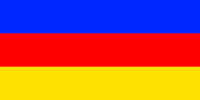Country of Cisamarra
| Cisamarra | |
| – Autonomous country – | |
| Paese di Cisamarra Shisamaralla | |
|
| |
| Capital | Acquecalde |
| Largest cities | Porto Napole, Fenicottero, Monsanto |
|
| |
| Population | |
|
6,643,710 (1690) |
|
105.18 per km2 |
|
6 of 21 |
|
| |
| Area | |
|
63,168 km2 |
|
TBD of 21 |
|
| |
| Government | |
|
|
|
Consiljo Nazjonale (235) |
|
| |
| National representation | |
| TBD MLs | |
|
| |
| Official language(s) | Cisamarrese |
| Other language(s) | Sanaman |
| Local religion | Cedrism, Nazarenism, Somanes, others, irreligion |
| Subdivision code | CIS |
The Country of Country of Cisamarra was the westernmost area of Sanama and an autonomous country. The country had a population of over 6.5 million people and an area of 63,000 km2. The previous province was formed in 1679 with the passage of the new federal constitution and was coterminous with the previous Cisamarra region. The country was situated between the Forest of Malarbor and the Ama River, rising slowly from the coast into the northern highlands. It was bordered to the west by Tellia, to the north by Highpass, to the east by Xolaso, to the southeast by Lagunas, and to the southwest by the Cosimo Sea. The capital Acquecalde is located in the south by Acquecalde Bay. In 1700 the Republic of Cisamarra was proclaimed.
Geography
The province is wedged between the Forest of Malarbor to the east and the Ama river to the west, forming the border with Tellia. Much of the scenery in the southern parts are rolling hills with vineyards, grazing land for cattle, sweet potato fields, and farms for figs, dates and olives. The capital Acquecalde is situated at a bay formed by the mainland and the Catambria Peninsula to the south. There are several sandy beaches along the coast, forming popular leisure destinations for people from Cisamarra and south Western Amarra. The center of the province is dominated by forests, both branches of the vast Malarbor forest, but also smaller forests formed by vast corn fields. In the north the province rises into the highlands, where forestry and limited mining operations provide employment for the local population.
Economy
The economic life of the province is dominated by the auto manufacturer Faca, with plants in Acquecalde and Rosaria and a vast local supplier network. The second largest employer in the south is the Sanaman Navy with the Porto Napole Naval Base. The facility is the home base for the submarine fleet and also provides maintenance and service work for the Navy and Coast Guard. In addition to this, Acquecalde has a growing entertainment industry with several casinos, the most prominent being the Casino della Baia owned by Apishe Group. Further north farming and forestry provides employment opportunities, and in the north several private companies are expanding their mining operations. A hydroelectric dam is also under construction in the northern parts, which will when active have a capacity of approximately 2,200 MW.
Politics
Cisamarra is governed by the Presidente della Provincja, or President of the Province, elected by the legislature for five-year terms. They are the ex officio chairperson of the Gjunta Provincjale, or Provincial Government, and appoints ten members of the government. The 235-member Consigljo Provincjale, or Provincial Council, is the legislative branch of the provincial government, elected by the people for five-year terms. The province has been governed by the Partito Popolare Cisamarrese since its formation in 1679. The party dominates the political life on all levels of government, especially in the provincial government and the Acquecalde city government. The party enjoys exceptionally strong support from the Cisamarrese majority population, while the minority Ama population usually vote for other parties. The complete dominance of the PPC has been described as a de facto one-party system, a description that the PPC strongly denies. Connections between the party and organised crime in Acquecalde are also common knowledge, even though no prosecution has been initiated.
Culture
The culture in Cisamarra is heavily dominated by the majority Cisamarrese population. Three in four Cisamarrans are Cisamarrese speakers and around one in eight are Ama speakers. The Cisamarrese culture is strongly influenced by the Nazarene faith and is quite similar to that in Tellia on the other side of the Ama river, but with several distinguishing traits. Ama speakers can mainly be found along the border with Eastern Amarra, as well as on Napole peninsula. Acquecalde has several theatres as well as the Acquecalde Opera, one of the most respected opera establishments in Sanama. During autumn every year the city celebrates the Passione di Yeshua, a retelling of the suffering of Yeshua leading up to and including his execution. A large procession carrying statues and crosses led by the Flagellati, young men dressed in white beating each other with whips, begins at Acquecalde Cathedral and ends on Monte Siscino just outside the city. Further to the north in Nuovo Romero, the people celebrate the annual summer festival Festival del Vino e Canto, or Festival of Wine and Song.
History
| |||||||||||||||||||||||


